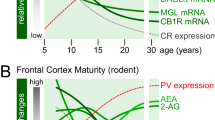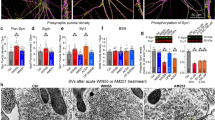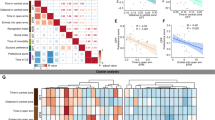Abstract
The endogenous cannabinoid system is involved in the regulation of the central reward pathway. Running wheel and sucrose consumption have rewarding and reinforcing properties in rodents, and share many neurochemical and behavioral characteristics with drug addiction. In this study, we investigated whether running wheel or sucrose consumption altered the sensitivity of striatal synapses to the activation of cannabinoid CB1 receptors. We found that cannabinoid CB1 receptor-mediated presynaptic control of striatal inhibitory postsynaptic currents was remarkably potentiated after these environmental manipulations. In contrast, the sensitivity of glutamate synapses to CB1 receptor stimulation was unaltered, as well as that of GABA synapses to the stimulation of presynaptic GABAB receptors. The sensitization of cannabinoid CB1 receptor-mediated responses was slowly reversible after the discontinuation of running wheel or sucrose consumption, and was also detectable following the mobilization of endocannabinoids by metabotropic glutamate receptor 5 stimulation. Finally, we found that the upregulation of cannabinoid transmission induced by wheel running or sucrose had a crucial role in the protective effects of these environmental manipulations against the motor and synaptic consequences of stress.
Similar content being viewed by others
Log in or create a free account to read this content
Gain free access to this article, as well as selected content from this journal and more on nature.com
or
References
Acquas E, Di Chiara G (1994). D1 receptor blockade stereospecifically impairs the acquisition of drug-conditioned place preference and place aversion. Behav Pharmacol 5: 555–569.
Avgustinovich DF, Kovalenko IL, Koryakina LA (2005). A model of anxious depression: persistence of behavioral pathology. Neurosci Behav Physiol 35: 917–924.
Belke TW (1997). Running and responding reinforced by the opportunity to run: effect of reinforcer duration. J Exp Anal Behav 67: 337–351.
Beltramo M, de Fonseca FR, Navarro M, Calignano A, Gorriti MA, Grammatikopoulos G et al. (2000). Reversal of dopamine D(2) receptor responses by an anandamide transport inhibitor. J Neurosci 20: 3401–3407.
Berton O, McClung CA, Dileone RJ, Krishnan V, Renthal W, Russo SJ et al. (2006). Essential role of BDNF in the mesolimbic dopamine pathway in social defeat stress. Science 311: 864–868.
Calabresi P, Mercuri NB, De Murtas M, Bernardi G (1991). Involvement of GABA systems in feedback regulation of glutamate-and GABA-mediated synaptic potentials in rat neostriatum. J Physiol 440: 581–599.
Centonze D, Battista N, Rossi S, Mercuri NB, Finazzi-Agro A, Bernardi G et al. (2004). A critical interaction between dopamine D2 receptors and endocannabinoids mediates the effects of cocaine on striatal GABAergic transmission. Neuropsychopharmacology 29: 1488–1497.
Centonze D, Rossi S, De Chiara V, Prosperetti C, Battista N, Bernardi G et al. (2007a). Chronic cocaine sensitizes striatal GABAergic synapses to the stimulation of cannabinoid CB1 receptors. Eur J Neurosci 25: 1631–1640.
Centonze D, Rossi S, Prosperetti C, Gasperi V, De Chiara V, Bari M et al. (2007b). Endocannabinoids limit metabotropic glutamate 5 receptor-mediated synaptic inhibition of striatal principal neurons. Mol Cell Neurosci 35: 302–310.
Centonze D, Rossi S, Prosperetti C, Tscherter A, Bernardi G, Maccarrone M et al. (2005). Abnormal sensitivity to cannabinoid receptor stimulation might contribute to altered gamma-aminobutyric acid transmission in the striatum of R6/2 Huntington's disease mice. Biol Psychiatry 57: 1583–1589.
Chaperon F, Soubrie P, Puech AJ, Thiebot MH (1998). Involvement of central cannabinoid (CB1) receptors in the establishment of place conditioning in rats. Psychopharmacology 135: 324–332.
Colantuoni C, Rada P, McCarthy J, Patten C, Avena NM et al (2004). Evidence that intermittent, excessive sugar intake causes endogenous opioid dependence. Obes Res 10: 478–488.
Cossu G, Ledent C, Fattore L, Imperato A, Bohme GA, Parmentier M et al. (2001). Cannabinoid CB1 receptor knockout mice fail to self-administer morphine but not other drugs of abuse. Behav Brain Res 118: 61–65.
Cota D, Marsicano G, Lutz B, Vicennati V, Stalla GK, Pasquali R et al. (2003). Endogenous cannabinoid system as a modulator of food intake. Int J Obes Relat Metab Disord 27: 289–301.
d’Anci KE, Kanarek RB, Marks-Kaufman R (1996). Duration of sucrose availability differentially alters morphine-induced analgesia in rats. Pharmacol Biochem Behav 54: 693–697.
de Visser L, van den Bos R, Stoker AK, Kas MJ, Spruijt BM (2007). Effects of genetic background and environmental novelty on wheel running as a rewarding behaviour in mice. Behav Brain Res 177: 290–297.
De Vries TJ, Schoffelmeer AN (2005). Cannabinoid CB1 receptors control conditioned drug seeking. Trends Pharmacol Sci 26: 420–426.
Di Chiara G, Imperato A (1988). Drugs abused by humans preferentially increase synaptic dopamine concentrations in the mesolimbic system of freely moving rats. Proc Natl Acad Sci USA 85: 5274–5278.
El Rawas R, Thiriet N, Lardeux V, Jaber M, Solinas M (2009). Environmental enrichment decreases the rewarding but not the activating effects of heroin. Psychopharmacology 203: 561–570.
Errico F, Santini E, Migliarini S, Borgkvist A, Centonze D, Nasti V et al. (2008). The GTP binding protein Rhes modulates dopamine signalling in striatal medium spiny neurons. Mol Cell Neurosci 37: 335–345.
Fattore L, Spano MS, Deiana S, Melis V, Cossu G, Fadda P et al. (2007). An endocannabinoid mechanism in relapse to drug seeking: a review of animal studies and clinical perspectives. Brain Res Rev 53: 1–16.
Gerdeman G, Lovinger DM (2001). CB1 cannabinoid receptor inhibits synaptic release of glutamate in rat dorsolateral striatum. J Neurophysiol 85: 468–471.
Gerdeman GL, Ronesi J, Lovinger DM (2002). Postsynaptic endocannabinoid release is critical to long-term depression in the striatum. Nat Neurosci 5: 446–451.
Gerdeman GL, Partridge JG, Lupica CR, Lovinger DM (2003). It could be habit forming: drugs of abuse and striatal synaptic plasticity. Trends Neurosci 26: 184–192.
Giuffrida A, Parsons LH, Kerr TM, Rodriguez de Fonseca F, Navarro M, Piomelli D (1999). Dopamine activation of endogenous cannabinoid signaling in dorsal striatum. Nat Neurosci 2: 358–363.
Gustafson N, Gireesh-Dharmaraj E, Czubayko U, Blackwell KT, Plenz D (2006). A comparative voltage and current–clamp analysis of feedback and feedforward synaptic transmission in the striatal microcircuit in vitro. J Neurophysiol 95: 737–752.
Guzman JN, Hernandez A, Galarraga E, Tapia D, Laville A, Vergara R et al. (2003). Dopaminergic modulation of axon collaterals interconnecting spiny neurons of the rat striatum. J Neurosci 23: 8931–8940.
Hajnal A, Smith GP, Norgren R (2004). Oral sucrose stimulation increases accumbens dopamine in the rat. Am J Physiol Regul Integr Comp Physiol 286: R31–R37.
Herkenham M, Lynn AB, de Costa BR, Richfield EK (1991). Neuronal localization of cannabinoid receptors in the basal ganglia of the rat. Brain Res 547: 267–274.
Higuera-Matas A, Luisa Soto-Montenegro M, Del Olmo N, Miguéns M, Torres I, José Vaquero J et al. (2008). Augmented acquisition of cocaine self-administration and altered brain glucose metabolism in adult female but not male rats exposed to a cannabinoid agonist during adolescence. Neuropsychopharmacology 33: 806–813.
Hoffmann P, Thorén P, Ely D (1987). Effect of voluntary exercise on open-field behavior and on aggression in the spontaneously hypertensive rat (SHR). Behav Neural Biol 47: 346–355.
Hohmann AG, Herkenham M (2000). Localization of cannabinoid CB(1) receptor mRNA in neuronal subpopulations of rat striatum: a double-label in situ hybridization study. Synapse 37: 71–80.
Huang CC, Lo SW, Hsu KS (2001). Presynaptic mechanisms underlying cannabinoid inhibition of excitatory synaptic transmission in rat striatal neurons. J Physiol 532: 731–748.
Iversen IH (1993). Techniques for establishing schedules with wheel running as reinforcement in rats. J Exp Anal Behav 60: 219–238.
Jung KM, Mangieri R, Stapleton C, Kim J, Fegley D, Wallace M et al. (2005). Stimulation of endocannabinoid formation in brain slice cultures through activation of group I metabotropic glutamate receptors. Mol Pharmacol 68: 1196–1202.
Kanarek RB, Mathes WF, Heisler LK, Lima RP, Monfared LS (1997). Prior exposure to palatable solutions enhances the effects of naltrexone on food intake in rats. Pharmacol Biochem Behav 57: 377–381.
Kelley AE (2004). Memory and addiction: shared neural circuitry and molecular mechanisms. Neuron 44: 161–179.
Koos T, Tepper JM, Wilson CJ (2004). Comparison of IPSCs evoked by spiny and fast-spiking neurons in the neostriatum. J Neurosci 24: 7916–7922.
Larson EB, Carroll ME (2005). Wheel running as a predictor of cocaine self-administration and reinstatement in female rats. Pharmacol Biochem Behav 82: 590–600.
Ledent C, Valverde O, Cossu G, Petitet F, Aubert JF, Beslot F et al. (1999). Unresponsiveness to cannabinoids and reduced addictive effects of opiates in CB1 receptor knockout mice. Science 283: 401–404.
Le Foll B, Goldberg SR (2005). Cannabinoid CB1 receptor antagonists as promising new medications for drug dependence. J Pharmacol Exp Ther 312: 875–883.
Lenoir M, Serre F, Cantin L, Ahmed SH (2007). Intense sweetness surpasses cocaine reward. PLoS ONE 2: e698.
Lett BT, Grant VL, Byrne MJ, Koh MT (2000). Pairings of a distinctive chamber with the aftereffect of wheel running produce conditioned place preference. Appetite 34: 87–94.
Lett BT, Grant VL, Koh MT (2001). Naloxone attenuates the conditioned place preference induced by wheel running in rats. Physiol Behav 72: 355–358.
Levine AS, Kotz CM, Gosnell BA (2003). Sugars: hedonic aspects, neuroregulation, and energy balance. Am J Clin Nutr 78: 834S–842S.
Lieblich I, Cohen E, Ganchrow JR, Blass EM, Bergmann F (1983). Morphine tolerance in genetically selected rats induced by chronically elevated saccharin intake. Science 221: 871–873.
Maccarrone M, Rossi S, Bari M, De Chiara V, Fezza F, Musella A et al. (2008). Anandamide inhibits metabolism and physiological actions of 2-arachidonoylglycerol in the striatum. Nat Neurosci 11: 152–159.
Mahler SV, Smith KS, Berridge KC (2007). Endocannabinoid hedonic hotspot for sensory pleasure: anandamide in nucleus accumbens shell enhances ‘liking’ of a sweet reward. Neuropsychopharmacology 32: 2267–2278.
Mark GP, Blander DS, Hoebel BG (1991). A conditioned stimulus decreases extracellular dopamine in the nucleus accumbens after the development of a learned taste aversion. Brain Res 551: 308–310.
Martin M, Ledent C, Parmentier M, Maldonado R, Valverde O (2000). Cocaine, but not morphine, induces conditioned place preference and sensitization to locomotor responses in CB1 knockout mice. Eur J Neurosci 12: 4038–4046.
Narushima M, Uchigashima M, Fukaya M, Matsui M, Manabe T, Hashimoto K et al. (2007). Tonic enhancement of endocannabinoid-mediated retrograde suppression of inhibition by cholinergic interneuron activity in the striatum. J Neurosci 27: 496–506.
Parolaro D, Vigano D, Rubino T (2005). Endocannabinoids and drug dependence. Curr Drug Targets CNS Neurol Disord 4: 643–655.
Plenz D (2003). When inhibition goes incognito: feedback interaction between spiny projection neurons in striatal function. Trends Neurosci 26: 436–443.
Pontieri FE, Tanda G, Orzi F, Di Chiara G (1996). Effects of nicotine on the nucleus accumbens and similarity to those of addictive drugs. Nature 382: 255–387.
Rossi S, De Chiara V, Musella A, Kusayanagi H, Mataluni G, Bernardi G et al. (2008). Chronic psychoemotional stress impairs cannabinoid receptor-mediated control of GABA transmission in the striatum. J Neurosci 28: 7284–7292.
Rudski JM, Billington CJ, Levine AS (1997). A sucrose-based maintenance diet increases sensitivity to appetite suppressant effects of naloxone. Pharmacol Biochem Behav 58: 679–682.
Simiand J, Keane M, Keane PE, Soubrie P (1998). SR 141716, a CB1 cannabinoid receptor antagonist, selectively reduces sweet food intake in marmoset. Behav Pharmacol 9: 179–181.
Sonnier L, Le Pen G, Hartmann A, Bizot JC, Trovero F, Krebs MO et al. (2007). Progressive loss of dopaminergic neurons in the ventral midbrain of adult mice heterozygote for Engrailed1. J Neurosci 27: 1063–1071.
Sparling PB, Giuffrida A, Piomelli D, Rosskopf L, Dietrich A (2003). Exercise activates the endocannabinoid system. Neuroreport 14: 2209–2211.
Stern EA, Jaeger D, Wilson CJ (1998). Membrane potential synchrony of simultaneously recorded striatal spiny neurons in vivo. Nature 394: 475–478.
Tepper JM, Koos T, Wilson CJ (2004). GABAergic microcircuits in the neostriatum. Trends Neurosci 27: 662–669.
Tunstall MJ, Oorschot DE, Kean A, Wickens JR (2002). Inhibitory interactions between spiny projection neurons in the rat striatum. J Neurophysiol 88: 1263–1269.
Tzschentke TM (1998). Measuring reward with the conditioned place preference paradigm: a comprehensive review of drug effects, recent progress and new issues. Prog Neurobiol 56: 613–672.
Uchigashima M, Narushima M, Fukaya M, Katona I, Kano M, Watanabe M (2007). Subcellular arrangement of molecules for 2-arachidonoyl-glycerol-mediated retrograde signaling and its physiological contribution to synaptic modulation in the striatum. J Neurosci 27: 3663–3676.
Volkow ND, Wise RA (2005). How can drug addiction help us understand obesity? Nat Neurosci 8: 555–560.
Ward SJ, Dykstra LA (2005). The role of CB1 receptors in sweet versus fat reinforcement: effect of CB1 receptor deletion, CB1 receptor antagonism (SR141716A) and CB1 receptor agonism (CP-55940). Behav Pharmacol 16: 381–388.
Werme M, Thoren P, Olson L, Brene S (2000). Running and cocaine both upregulate dynorphin mRNA in medial caudate putamen. Eur J Neurosci 12: 2967–2974.
Werme M, Messer C, Olson L, Gilden L, Thoren P, Nestler EJ et al. (2002). Delta FosB regulates wheel running. J Neurosci 22: 8133–8138.
Wilson CJ, Kawaguchi Y (1996). The origins of two-state spontaneous membrane potential fluctuations of neostriatal spiny neurons. J Neurosci 16: 2397–2410.
Zhou D, Shearman LP (2004). Voluntary exercise augments acute effects of CB1-receptor inverse agonist on body weight loss in obese and lean mice. Pharmacol Biochem Behav 77: 117–125.
Acknowledgements
This investigation was supported by grants from the Italian Ministero dell’Università e della Ricerca and from the Italian Ministero della Salute to DC. AU represents Mariano Scippacercola Foundation.
Author information
Authors and Affiliations
Corresponding author
Additional information
DISCLOSURE
The authors declare no conflict of interest.
Rights and permissions
About this article
Cite this article
De Chiara, V., Errico, F., Musella, A. et al. Voluntary Exercise and Sucrose Consumption Enhance Cannabinoid CB1 Receptor Sensitivity in the Striatum. Neuropsychopharmacol 35, 374–387 (2010). https://doi.org/10.1038/npp.2009.141
Received:
Revised:
Accepted:
Published:
Issue date:
DOI: https://doi.org/10.1038/npp.2009.141
Keywords
This article is cited by
-
Beneficial Effects of Physical Activity and Crocin Against Adolescent Stress Induced Anxiety or Depressive-Like Symptoms and Dendritic Morphology Remodeling in Prefrontal Cortex in Adult Male Rats
Neurochemical Research (2019)
-
Motivational wheel running reverses cueing behavioural inflexibility in rodents
Journal of Neural Transmission (2017)
-
Interaction between interleukin-1β and type-1 cannabinoid receptor is involved in anxiety-like behavior in experimental autoimmune encephalomyelitis
Journal of Neuroinflammation (2016)
-
Deletion of G-protein-coupled receptor 55 promotes obesity by reducing physical activity
International Journal of Obesity (2016)
-
Neurobiological Interactions Between Stress and the Endocannabinoid System
Neuropsychopharmacology (2016)



